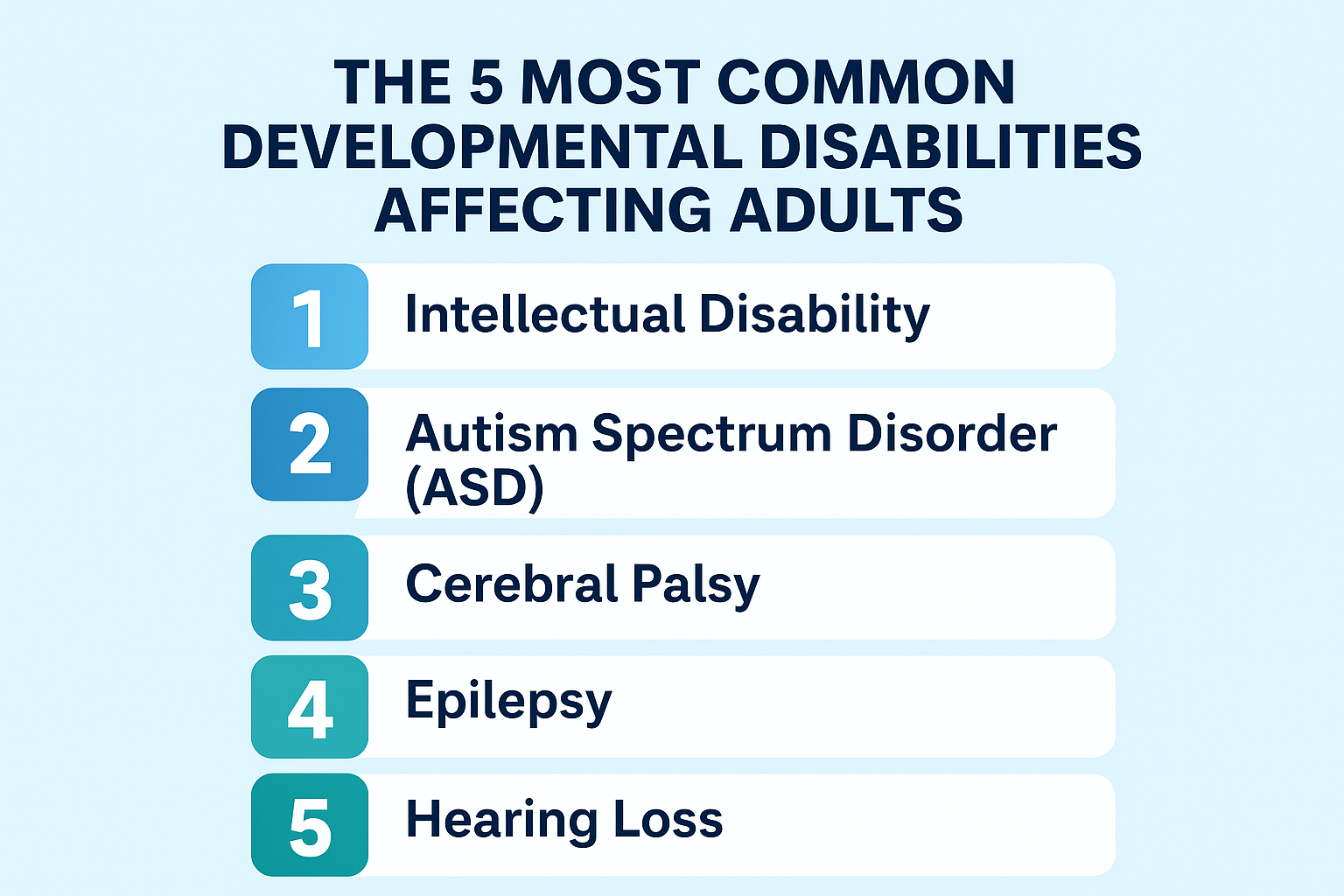The 5 Most Common Developmental Disabilities Affecting Adults
Developmental disabilities are a group of conditions that arise from impairments in physical, learning, language, or behavioral areas. These conditions typically begin during childhood, may impact daily functioning, and often last throughout a person’s lifetime. While each disability presents unique challenges, many children and adults with developmental disabilities can lead fulfilling lives with the right support, treatment, and understanding.
For parents and caregivers, awareness is key. Recognizing early signs, accessing resources, and knowing how to provide the right kind of support can make a significant difference in a child’s development and quality of life. Families who are informed are better equipped to advocate for their child’s needs at home, in school, and in healthcare settings.
The purpose of this blog is to clearly explain what the five main developmental disabilities are, highlight their common signs and challenges, and provide practical guidance for parents and caregivers. By understanding these conditions, families can feel more confident in supporting their children and ensuring they receive the care and opportunities they deserve.
What Is Developmental Disability?
A developmental disability is a condition that results from physical, cognitive, or behavioral impairments that begin during the developmental period, usually before the age of 22. These disabilities can affect a person’s ability to learn, communicate, move, or interact with others, and they often last throughout an individual’s lifetime. While the degree of impact varies, many people with developmental disabilities benefit greatly from early diagnosis, therapy, and strong support systems.
It is important to distinguish between developmental delays and developmental disabilities. A developmental delay refers to when a child takes longer to reach milestones such as walking, talking, or social interaction than expected. With the right interventions, some delays can improve or even resolve over time. In contrast, a developmental disability is usually a lifelong condition that may not go away but can be managed with proper care, education, and resources.
The causes of developmental disabilities are varied and may include genetic factors such as chromosomal abnormalities, environmental influences such as exposure to toxins or infections during pregnancy, and complications at birth including lack of oxygen or premature delivery. In some cases, the exact cause may remain unknown. Regardless of the origin, understanding the condition early and seeking appropriate care plays a vital role in improving long-term outcomes.
What Are the 5 Developmental Disabilities?
When discussing disorders of development, professionals often refer to a core group of conditions that significantly impact learning, behavior, movement, and communication. Understanding this list of developmental disabilities helps parents and caregivers recognize early signs and access the right resources. If you have ever wondered which of the following are considered developmental disabilities, the most commonly identified five are Intellectual Disability, Autism Spectrum Disorder (ASD), Cerebral Palsy, Epilepsy, and Hearing Loss. These are not forms of mental illness, but rather lifelong conditions that affect development. Although mental illness and developmental disabilities may sometimes overlap, they are considered distinct categories of health concerns.
1. Intellectual Disability
Characteristics and challenges: Intellectual disability involves limitations in intellectual functioning and adaptive behaviors such as communication, social skills, and daily living activities. Children and adults may struggle with problem-solving, reasoning, or learning new skills.
Early signs parents may notice: Delayed speech, difficulty following instructions, slower development of motor skills, or challenges in school performance may indicate intellectual disability.
Support strategies: Support often includes special education programs, speech and occupational therapy, and individualized learning plans. Encouragement, patience, and structured routines at home can also make a meaningful difference.
2. Autism Spectrum Disorder (ASD)
Key symptoms and behaviors: Autism Spectrum Disorder is a developmental condition that affects communication, social interaction, and behavior. Symptoms may include difficulty with eye contact, limited interest in peer relationships, repetitive behaviors, or sensitivity to sensory input.
Range of severity: ASD is a spectrum, meaning individuals may experience mild challenges or significant impairments. Each child is unique, and their abilities can vary widely.
Interventions and therapies: Applied Behavior Analysis (ABA), speech therapy, and occupational therapy are often recommended. Early intervention can greatly improve outcomes, helping children develop stronger communication and social skills.
3. Cerebral Palsy
How it affects movement and muscle coordination: Cerebral Palsy is a neurological condition that affects muscle tone, movement, and posture. It is caused by abnormal brain development or damage to the developing brain.
Common causes and risk factors: Premature birth, lack of oxygen during delivery, or infections during pregnancy can increase the risk.
Supportive treatments: While there is no cure, treatments such as physical therapy, occupational therapy, medications to manage muscle stiffness, and in some cases, surgery can help improve mobility and independence.
4. Epilepsy
What it is and how it relates to brain function: Epilepsy is a disorder of the brain that causes recurring seizures. It is classified among developmental disabilities because it often begins in childhood and can impact cognitive, social, and physical development.
Signs and symptoms: Seizures are the primary symptom, but epilepsy may also cause changes in behavior, learning challenges, and difficulty concentrating.
Medical care and management: Treatment typically includes anti-seizure medications, dietary approaches like the ketogenic diet, and in certain cases, surgery. Consistent medical care and monitoring are crucial.
5. Hearing Loss
Impact on communication and learning: Hearing loss can affect a child’s ability to develop speech and language skills, leading to learning challenges if not identified early.
Early detection methods: Screening in infancy and early childhood helps identify hearing concerns before they affect development. Parents may notice a lack of response to sounds, delayed speech, or frequent ear infections.
Available assistive devices and therapies: Hearing aids, cochlear implants, and speech therapy can support communication and educational success. Early access to resources allows children with hearing loss to thrive in both school and social environments.
By understanding this list of developmental disabilities, parents and caregivers can take proactive steps to support their children. While developmental disabilities are lifelong, early diagnosis and comprehensive care can help individuals achieve greater independence and a better quality of life.
Importance of Early Diagnosis and Intervention
Early diagnosis helps children receive timely therapies and educational support during their most critical years of development.
Identifying developmental disabilities at a young age allows families to take proactive steps before challenges become harder to manage.
Timely intervention improves learning, communication, social interaction, and emotional growth.
Pediatricians can detect early signs during checkups, while therapists provide targeted support for speech, motor skills, or behavior.
Educators play a vital role by creating individualized learning plans tailored to each child’s unique needs.
Collaboration between doctors, therapists, and educators ensures a well-rounded support system for the child.
Children with autism often show significant improvements in communication and social skills when therapy begins early.
Early treatment for hearing loss, such as hearing aids or cochlear implants, allows children to develop language skills closer to their peers.
Success stories highlight how early intervention can transform challenges into opportunities, leading to greater independence and long-term quality of life.
Conclusion
Understanding the five main developmental disabilities, Intellectual Disability, Autism Spectrum Disorder, Cerebral Palsy, Epilepsy, and Hearing Loss, provides parents and caregivers with the knowledge needed to support their children effectively. Recognizing early signs, seeking timely evaluation, and accessing appropriate therapies can significantly improve a child’s growth, learning, and overall quality of life.
Parents and caregivers are encouraged to act early and stay proactive. The sooner support is provided, the greater the opportunity for children to reach their full potential. Building awareness, collaborating with medical professionals, therapists, and educators, and engaging with community resources can make a meaningful difference in managing developmental disabilities.
By staying informed and connected, families can create a supportive environment where children with developmental disabilities thrive, achieve greater independence, and enjoy a more fulfilling life.
Frequently Asked Questions
1. Is ADHD considered a developmental disability?
Yes, Attention-Deficit/Hyperactivity Disorder (ADHD) is generally considered a developmental disability. It is a neurodevelopmental disorder that affects attention, impulse control, and executive functioning, typically presenting in childhood and often continuing into adulthood.
2. Is anxiety a developmental disability?
No, anxiety itself is not classified as a developmental disability. While anxiety disorders can significantly impact daily functioning, they are considered mental health conditions rather than neurodevelopmental or intellectual disabilities.
3. What qualifies as a developmental disability?
A developmental disability is a chronic condition that originates during the developmental period (typically before age 22) and substantially limits one or more major life activities, such as learning, communication, mobility, or self-care. These disabilities are usually lifelong and include conditions like autism spectrum disorder, cerebral palsy, intellectual disability, and ADHD.
4. What are the 14 categories of disabilities?
The 14 categories of disabilities, often referenced in educational and legal frameworks (such as the Individuals with Disabilities Education Act in the U.S.), include:
Autism Spectrum Disorder
Deaf-Blindness
Developmental Delay
Emotional Disturbance
Hearing Impairment
Intellectual Disability
Multiple Disabilities
Orthopedic Impairment
Other Health Impairment
Specific Learning Disability
Speech or Language Impairment
Traumatic Brain Injury
Visual Impairment (including blindness)
Attention-Deficit/Hyperactivity Disorder (ADHD is sometimes included under “Other Health Impairment” depending on the framework)

